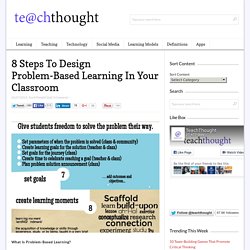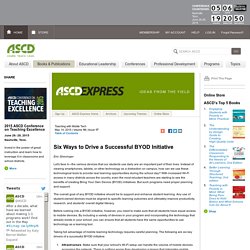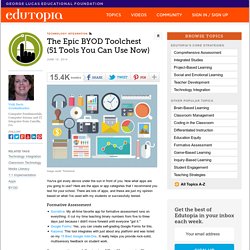

8 Steps To Design Problem-Based Learning In Your Classroom. What Is Problem-Based Learning?

By TeachThought Staff What is problem-based learning? One definition, if we want to start simple, is learning that is based around a problem. That is, the development, analysis, and thinking towards a problem drives student learning forward. What's the Future for Mobile Devices in the Classroom? Mobile devices are more prevalent in K–12 classrooms than ever.

A new survey on mobile learning from Project Tomorrow shows that today's schools are relying increasingly on students having experience with devices like smartphones and tablets to engage in modern curriculum. Project Tomorrow's 12th annual Speak Up Research Project surveyed teachers and students at more than 8,000 schools and 2,600 school districts to gain insight on how these devices are affecting education. The results were adapted into a report and an infographic. Key findings from the survey include: Express 10.17 - Six Ways to Drive a Successful BYOD Initiative. Six Ways to Drive a Successful BYOD Initiative Eric Sheninger Let's face it—the various devices that our students use daily are an important part of their lives.

Instead of viewing smartphones, tablets, or other technology as a distraction on campus, how can we use these technological tools to provide real learning opportunities during the school day? With increased Wi-Fi access in many districts across the country, even the most reluctant teachers are starting to see the benefits of creating Bring Your Own Device (BYOD) initiatives. But such programs need proper planning and support. The overall goal of any BYOD initiative should be to support and enhance student learning. Before rushing into a BYOD initiative, however, you need to make sure that all students have equal access to mobile devices. Taking full advantage of mobile learning technology requires careful planning. Infrastructure.
ASCD Express, Vol. 10, No. 17. BYOD.
BYOD. BYOD Is Shortest Path To Student-Centered Learning. By its very nature, BYOD is authentic.

As students bring their own devices—and with them, their own apps, accounts, and tech-use patterns—what is is naturally revealed, for better or for worse. With the mounting (and completely logical) demand for better technology in classrooms, BYOD is one response to that pressure. Why? BYOD gives students a chance. The Thinking Behind BYOD “Digital natives” or not, technology dropped into the laps of students in schools isn’t always as accessible as it might be.
BYOD provides students not just with a device, but apps–and thus pathways–to solve problems. Unfamiliar software. Unfamiliar hardware. While the best teachers mitigate this ahead of time by supplying log-ins, double-checking passwords, pairing students, offering screenshots, modeling the process on a projector, this is a tremendous waste of what many districts call “instructional time,” and what students call “school.” BYOD, on paper, solves a significant part of this issue. They trained teachers. 6 Benefits of BYOD In The Classroom. A few years ago, I decided to incorporate mobile devices into my lesson plans.

While the content still remains the focus of my teaching, I think technology can enhance learning at every point in a lesson. The Case for Banning Laptops in the Classroom. A colleague of mine in the department of computer science at Dartmouth recently sent an e-mail to all of us on the faculty.

The subject line read: “Ban computers in the classroom?” The note that followed was one sentence long: “I finally saw the light today and propose we ban the use of laptops in class.” While the sentiment in my colleague’s e-mail was familiar, the source was surprising: it came from someone teaching a programming class, where computers are absolutely integral to learning and teaching. Surprise turned to something approaching shock when, in successive e-mails, I saw that his opinion was shared by many others in the department. My friend’s epiphany came after he looked up from his lectern and saw, yet again, an audience of laptop covers, the flip sides of which were engaged in online shopping or social-media obligations rather than in the working out of programming examples. I banned laptops in the classroom after it became common practice to carry them to school. Byod. Social Media and Posting Information Online - Privacy In Saskatchewan Schools.
The Epic BYOD Toolchest (51 Tools You Can Use Now) You've got every device under the sun in front of you.

Now what apps are you going to use? Here are the apps or app categories that I recommend you test for your school. There are lots of apps, and these are just my opinion based on what I've used with my students or successfully tested. Formative Assessment Socrative: My all-time favorite app for formative assessment runs on everything. Screencasting and Capturing What Happens in Class If you're going to share and interact with your students in the electronic and physical spaces (as you should), you must learn how to screencast.
Byod guide revised 2012-09-05.